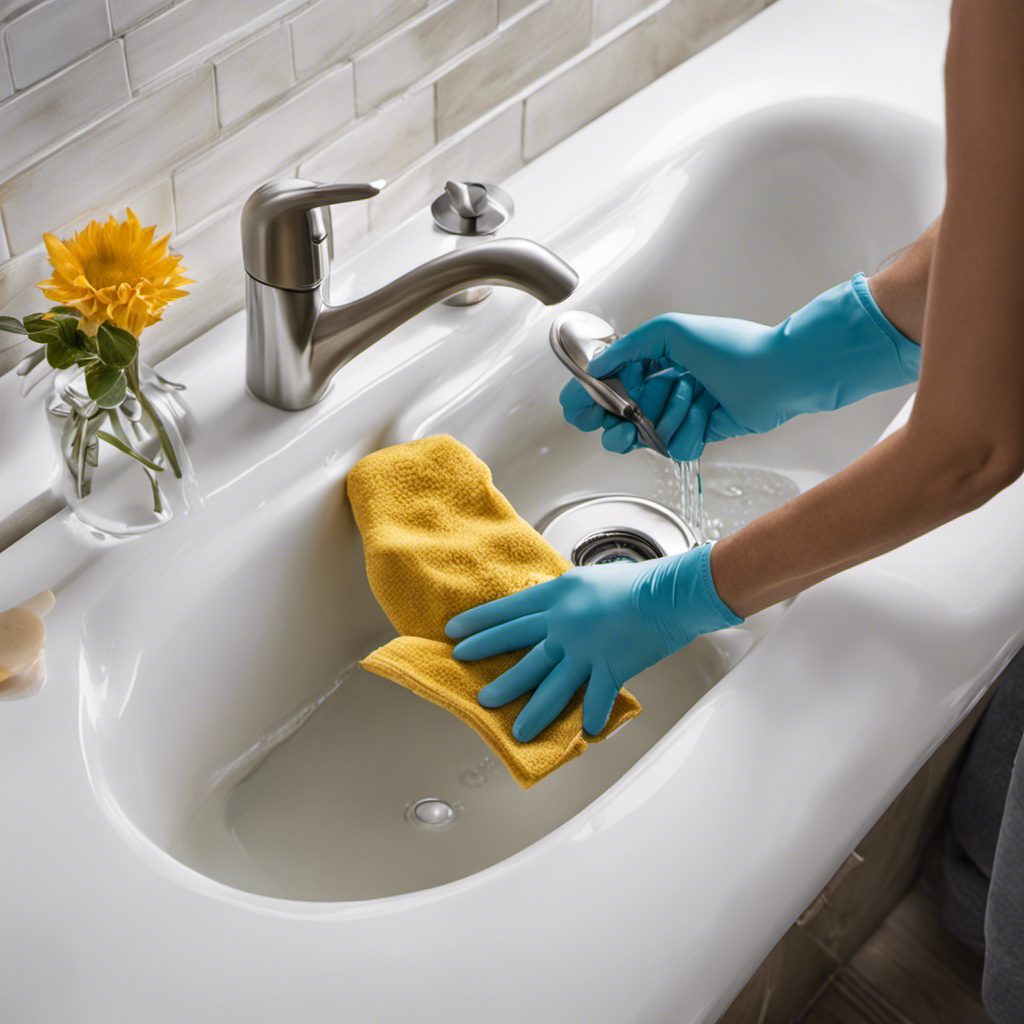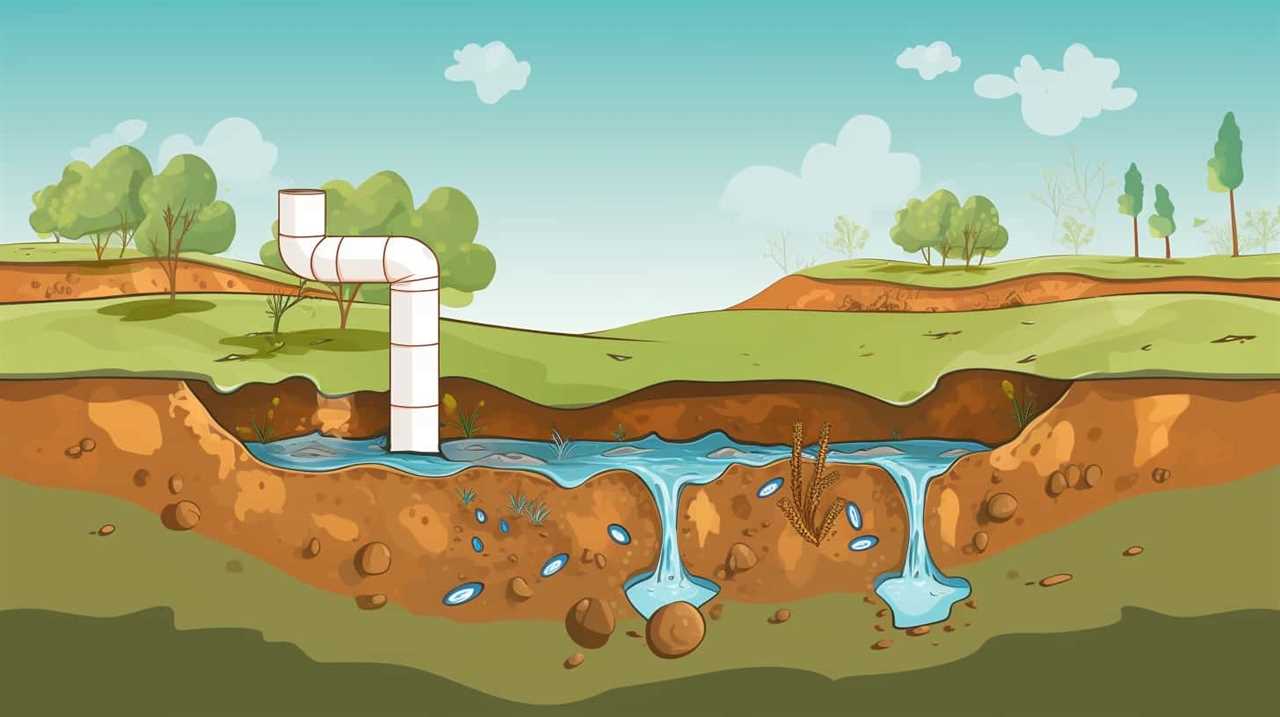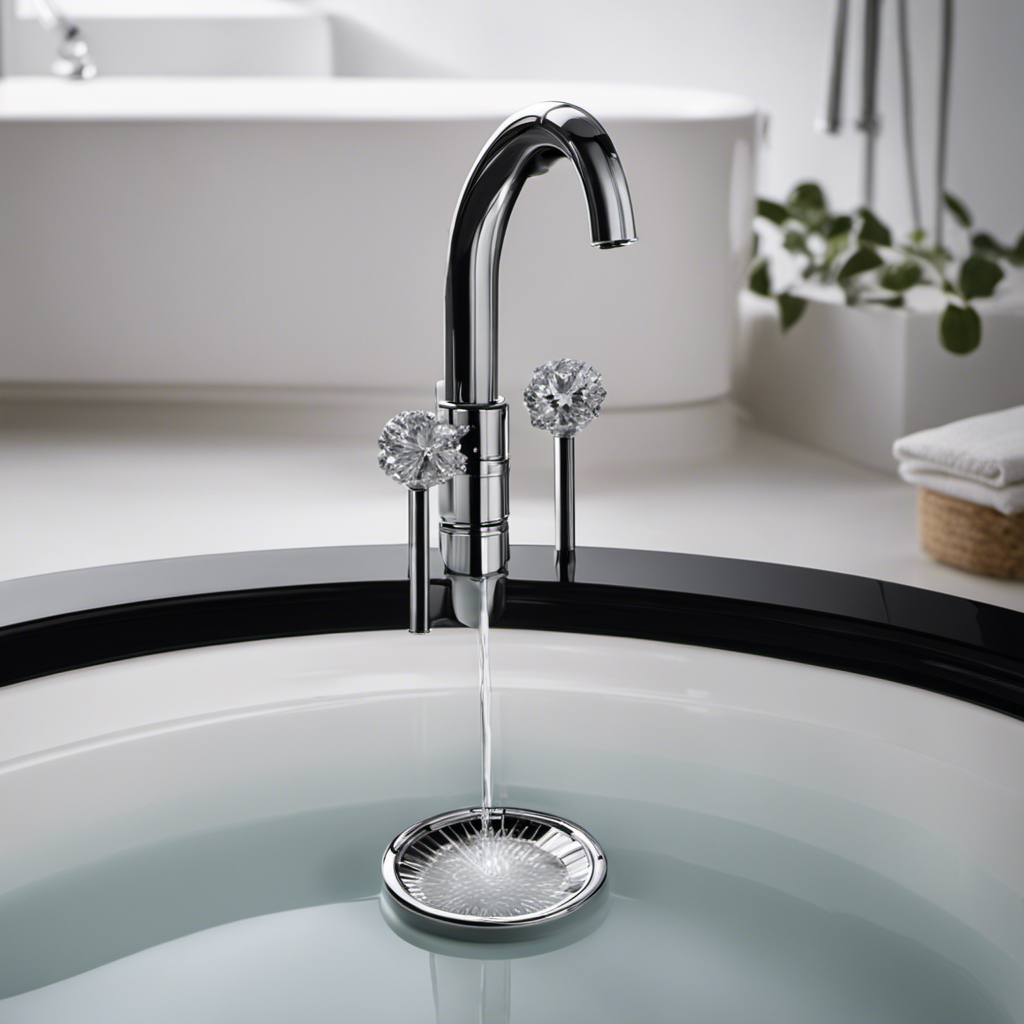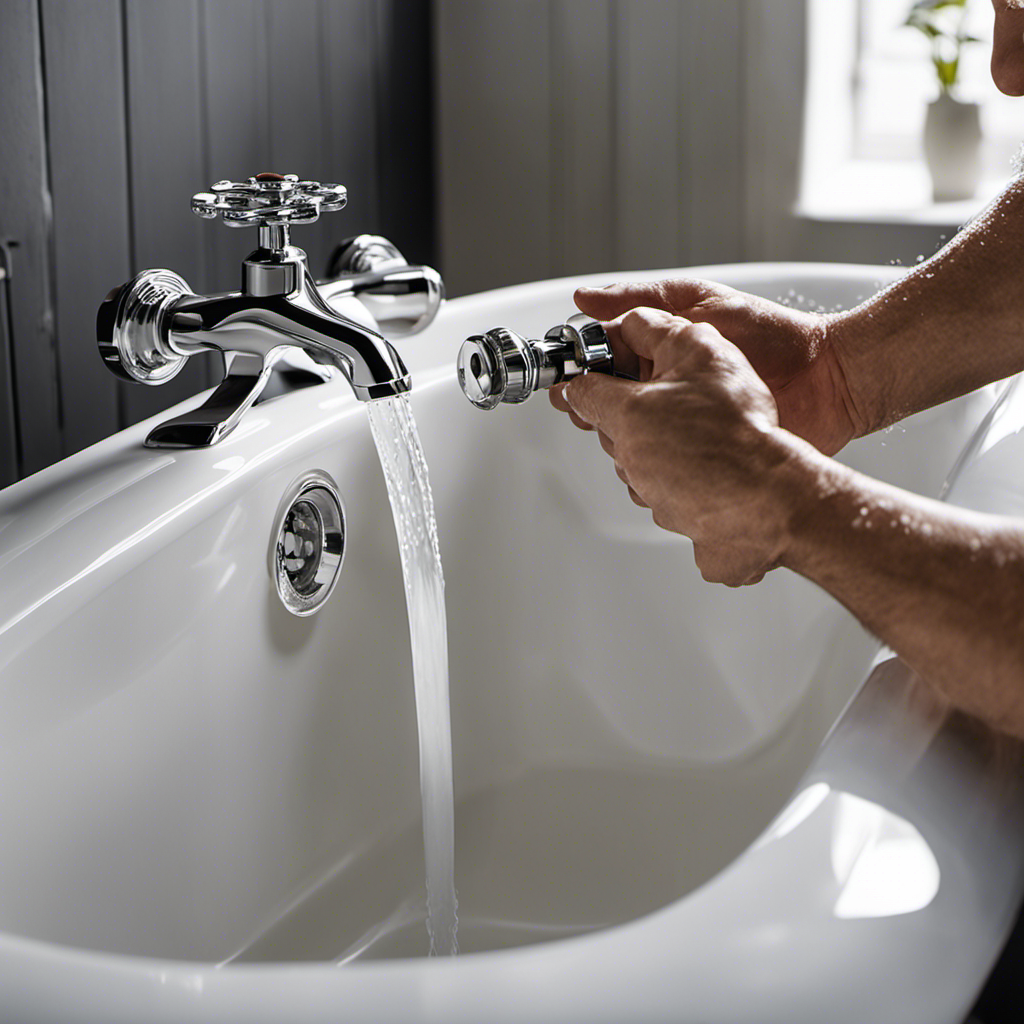As they say, ‘A clogged bathtub can be quite the hassle.’ But fear not, for I am here to guide you through the process of draining a clogged bathtub with ease.
In this article, we will explore the causes of bathtub clogs, the tools and supplies you’ll need, and various methods to unclog your drain.
With my expert knowledge and step-by-step instructions, you’ll be able to tackle any clog and prevent future ones.
Let’s get started!
Key Takeaways
- Slow or stagnant drainage is a sign of a clogged bathtub.
- Hair, soap scum, mineral deposits, and foreign objects are common causes of bathtub clogs.
- Essential tools for draining a clogged bathtub include a plunger, drain snake, bucket, protective gloves, and drain cleaner.
- Regularly cleaning the drain and using drain screens or covers can help prevent future clogs.
Identifying the Cause of the Clog
Now you need to figure out what’s causing the clog in your bathtub. Identifying common clog culprits is essential in order to effectively tackle the problem.
One of the signs of a clogged bathtub is slow or stagnant drainage. If water is taking longer than usual to drain or if it’s not draining at all, there’s likely a clog.
Another sign is water backing up into the bathtub when you flush the toilet or run the sink. This indicates a blockage in the main drainpipe.
Hair is one of the most common culprits of bathtub clogs. It accumulates over time and can easily obstruct the flow of water.
Other potential causes include soap scum, mineral deposits, and foreign objects that accidentally fall into the drain.
Identifying the cause of the clog is crucial in determining the appropriate solution.
Gathering the Necessary Tools and Supplies
Before we can tackle the task of unclogging a bathtub drain, it’s crucial to gather the essential tools and supplies. These include a plunger, a drain snake, a bucket, protective gloves, and a drain cleaner.
Proper preparation techniques must also be employed to ensure a successful outcome. This includes removing any excess water, clearing the surrounding area, and understanding the specific instructions for each tool and supply.
Essential Tools and Supplies
One of the essential tools you’ll need to drain a clogged bathtub is a plunger. It’s important to identify common clog culprits and troubleshoot drainage issues before attempting to remove the clog.
Here are some common culprits to watch out for:
- Hair: Hair is a major cause of bathtub clogs. It can easily accumulate in the drain and cause blockages.
- Soap scum: Soap residue can build up over time and obstruct the flow of water.
- Foreign objects: Small items like shampoo bottle caps or toys can accidentally find their way into the drain and cause clogs.
- Mineral deposits: Over time, minerals from hard water can accumulate and create blockages in the pipes.
By understanding these common culprits, you can better troubleshoot and address drainage issues.
Now let’s move on to the next section where we’ll discuss proper preparation techniques.
Proper Preparation Techniques
To properly prepare for tackling a clog in your bathtub, make sure you gather all the necessary tools and supplies. Proper preparation is essential to ensure a smooth and successful drain clearing process. Here are the key steps you need to follow in order to prepare yourself for this task:
-
Gather the Tools and Supplies:
- Plunger
- Drain snake
- Bucket or container
- Rubber gloves
- Safety goggles
-
Take Safety Precautions:
- Turn off the water supply to the bathtub
- Put on your rubber gloves and safety goggles to protect yourself from any potential splashes or spills
- Open windows or use a fan for proper ventilation
Removing the Bathtub Drain Cover
When it comes to maintaining the longevity of your bathtub drain cover, rust and corrosion prevention is key. By implementing proper maintenance techniques, such as regular cleaning and applying protective coatings, you can effectively prevent rust and corrosion from forming on the drain cover.
Additionally, it is important to be aware of the different types of drain covers available, as each type has its own unique features and benefits.
Rust and Corrosion Prevention
If you want to prevent rust and corrosion in your bathtub, make sure to regularly clean and dry it after each use. Rust can not only make your bathtub look unsightly, but it can also compromise its structural integrity over time.
Proper maintenance is key to keeping your bathtub in good condition and avoiding costly repairs. Here are some tips to prevent rust and corrosion:
- Use a mild, non-abrasive cleaner to regularly clean your bathtub.
- Avoid using harsh chemicals or abrasive scrubbers that can damage the surface.
- Dry the bathtub thoroughly after each use to prevent water from sitting and causing rust.
- Apply a protective coating or sealant to the bathtub to provide an extra layer of protection against rust and corrosion.
Different Drain Cover Types
For optimal drainage and to prevent debris buildup, consider using a mesh drain cover in your tub.
Mesh drain covers are one of the most common types of drain covers used in bathtub drains. They consist of a mesh screen that allows water to flow through while trapping hair and other debris. This helps to prevent clogs and keeps your drain functioning properly.
To maintain your mesh drain cover, it is important to clean it regularly. Remove any trapped hair or debris by simply pulling it off the cover and disposing of it. Additionally, you can use a mild detergent and a soft brush to scrub away any residue.
Using Chemical Drain Cleaners or Homemade Solutions
You can try using chemical drain cleaners or homemade solutions to unclog a bathtub. When it comes to choosing between chemical and natural drain cleaners, there are pros and cons to consider.
Here are some key points to keep in mind:
-
Chemical Drain Cleaners:
-
Pros:
-
Strong and effective at breaking down tough clogs.
-
Convenient and readily available in stores.
-
Can work quickly, providing instant results.
-
Most formulas are specifically designed for different types of clogs.
-
Cons:
-
Harsh chemicals can damage pipes and plumbing fixtures.
-
Some cleaners may contain toxic ingredients harmful to humans and the environment.
-
Strong fumes can be unpleasant and may require proper ventilation.
-
Not recommended for regular use as it can lead to long-term damage.
-
Homemade Solutions:
-
Pros:
-
Environmentally friendly and safe for the whole family.
-
Can be made using common household items, reducing costs.
-
Gentle on pipes and plumbing fixtures.
-
Regular use can help prevent future clogs.
-
Cons:
-
May not be as effective for stubborn or severe clogs.
-
Can take longer to break down the clog, requiring multiple applications.
-
Results may vary depending on the type and severity of the clog.
-
Homemade solutions may not be as readily available as chemical drain cleaners.
Remember to consider these pros and cons when choosing between chemical and natural drain cleaners for your clogged bathtub.
Employing Mechanical Methods to Clear the Clog
Using a plunger or plumbing snake is an effective way to clear a clog in the bathtub. These plumbing techniques are essential for any homeowner when it comes to clearing clogs.
The plunger, a simple yet powerful tool, creates pressure and suction to dislodge the blockage. To use it, place the plunger over the drain and push down firmly, then pull up quickly to create suction. Repeat this motion several times until the water starts to drain freely.
If the plunger doesn’t do the trick, a plumbing snake can be your next best option. This flexible tool is inserted into the drain and rotated to break up and remove the clog.
Preventing Future Bathtub Clogs
To prevent future clogs, it’s important to regularly clean the drain in your tub. Neglecting bathtub maintenance can lead to hair clogs that are not only frustrating but also time-consuming to clear. Here are some key practices to keep your drain running smoothly:
-
Use a drain cover: Place a drain cover over the drain to catch hair and prevent it from going down the drain in the first place.
-
Regularly remove hair: After each shower or bath, take a few moments to remove any hair that has accumulated on the drain cover or in the drain itself.
-
Flush with hot water: Once a week, pour a pot of hot water down the drain to help dissolve any buildup and keep the pipes clear.
-
Use a drain cleaner: Every few months, consider using a drain cleaner specifically designed to dissolve hair clogs and keep your drain flowing freely.
Conclusion
In conclusion, tackling a clogged bathtub is no small feat. Armed with determination and the right tools, I embarked on a mission to vanquish the stubborn clog that plagued my sanctuary of relaxation.
Through chemical warfare and mechanical prowess, I emerged victorious, reclaiming the smooth flow of water and restoring harmony to my bathroom oasis.
But let us not forget, dear readers, the true lesson here: prevention is the key to eternal bliss. Stay vigilant, for a clogged bathtub is a formidable foe that must be kept at bay.










